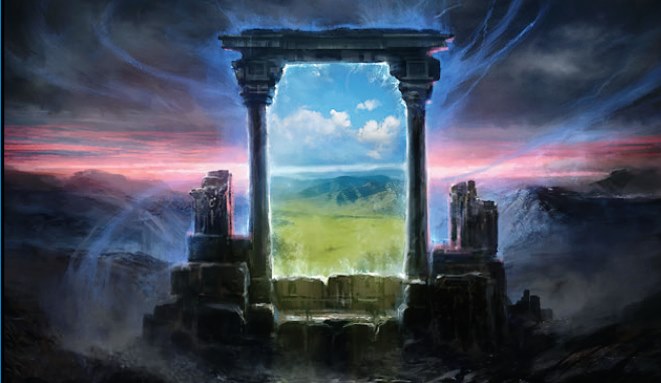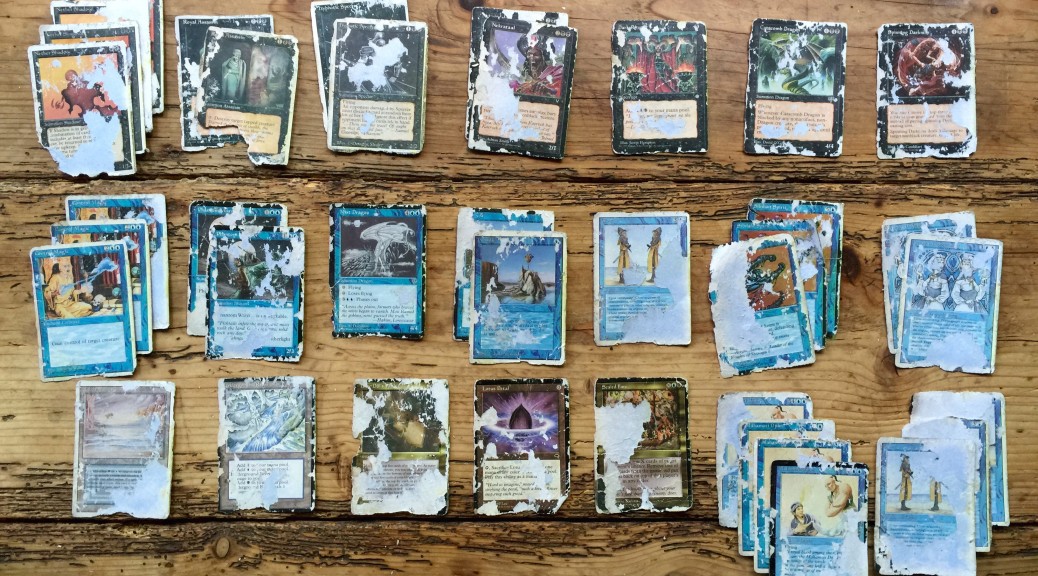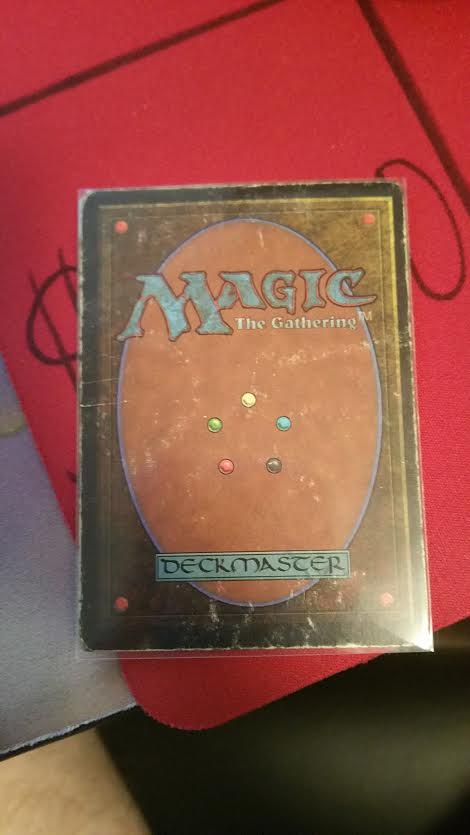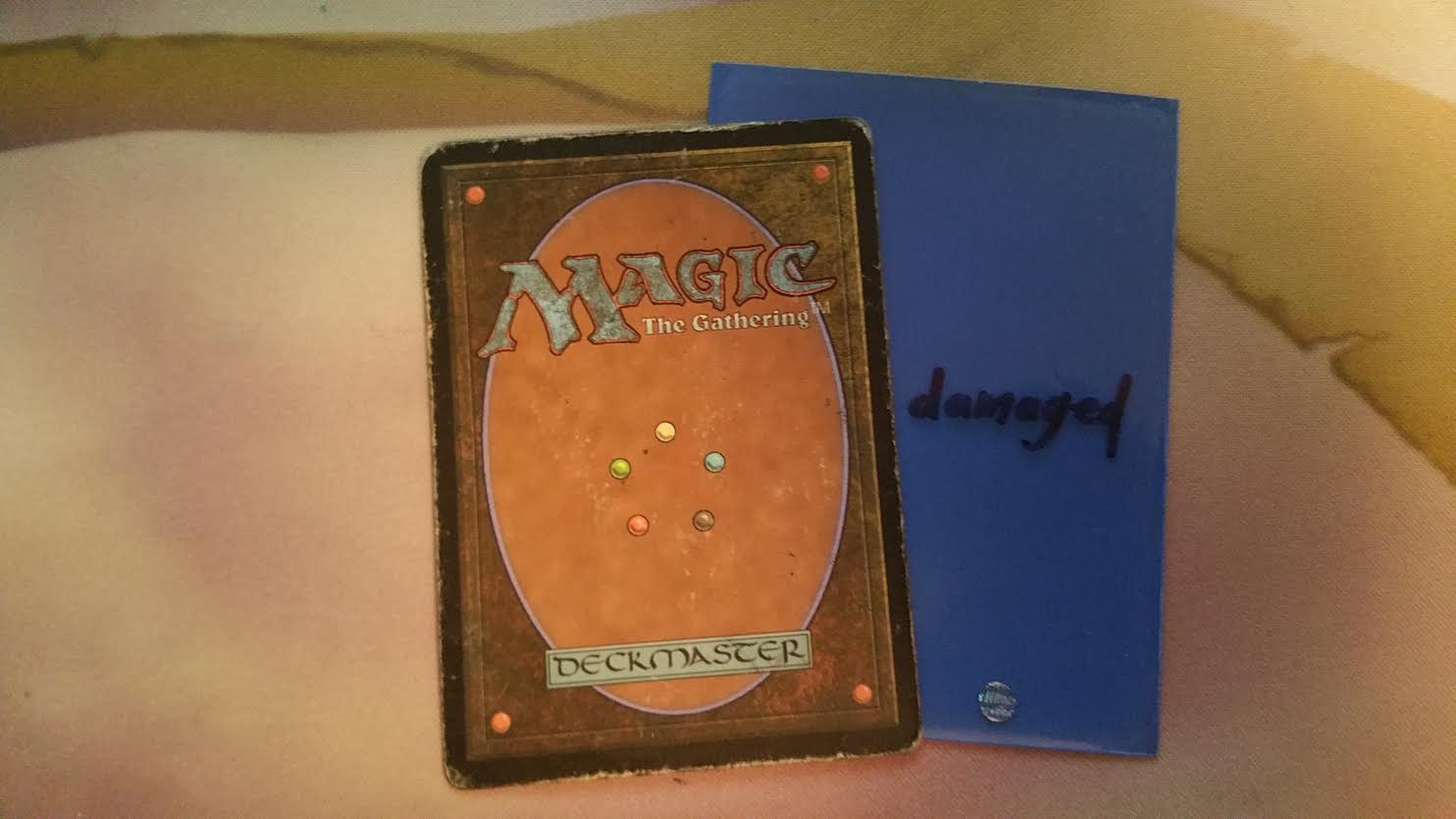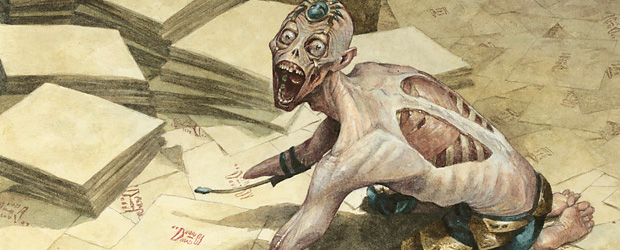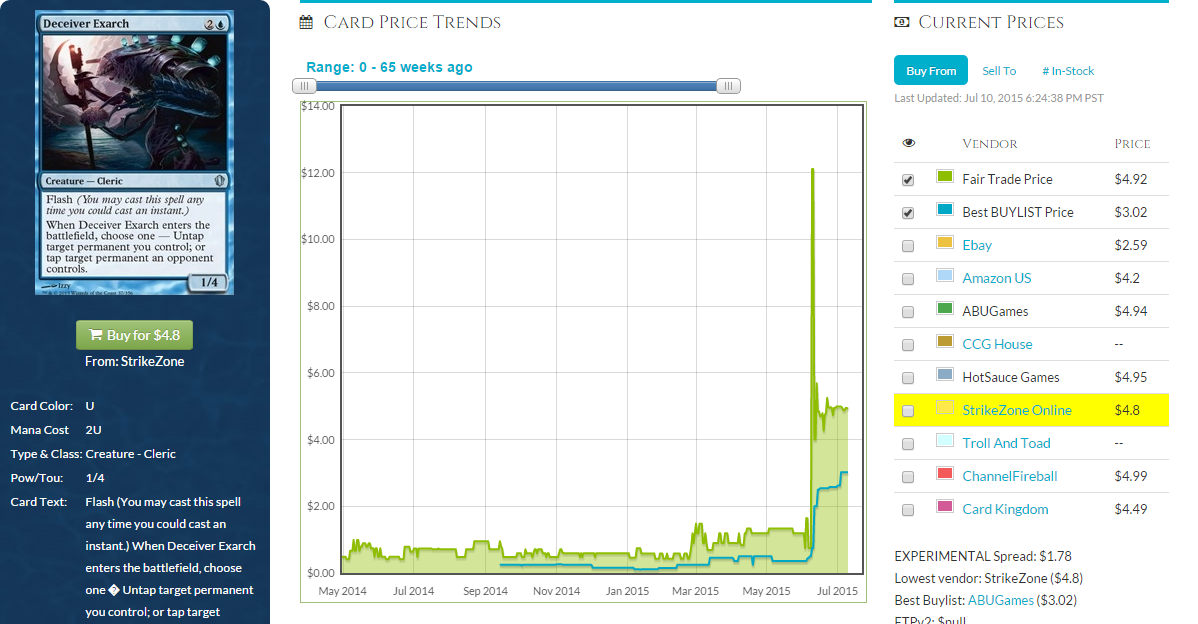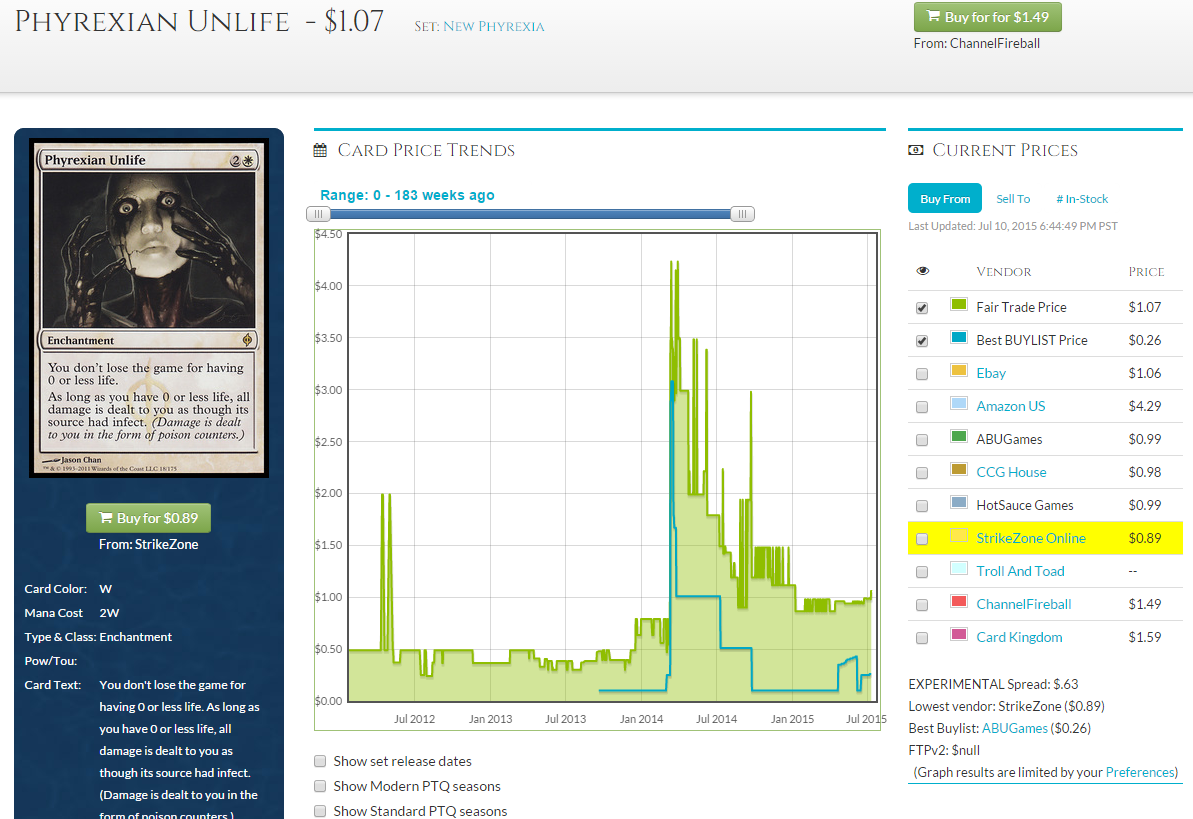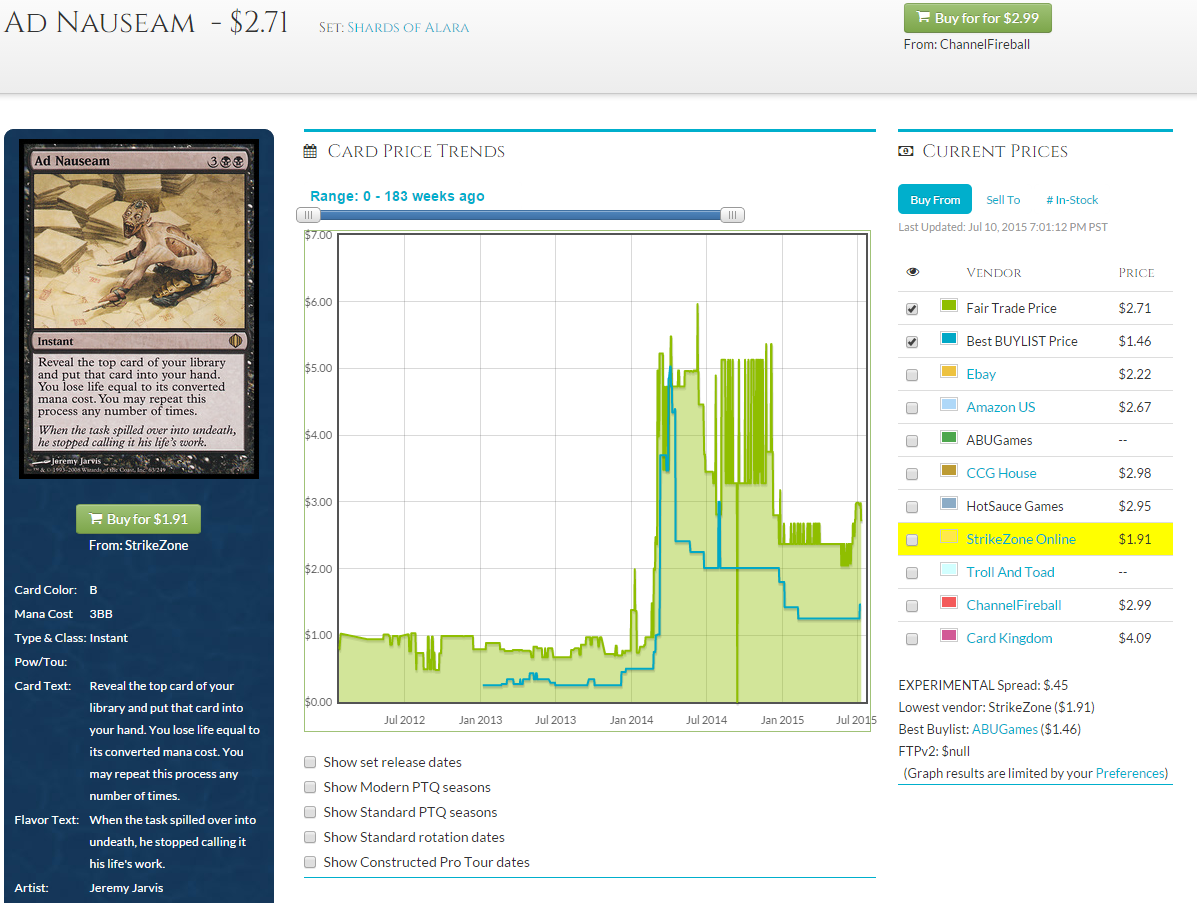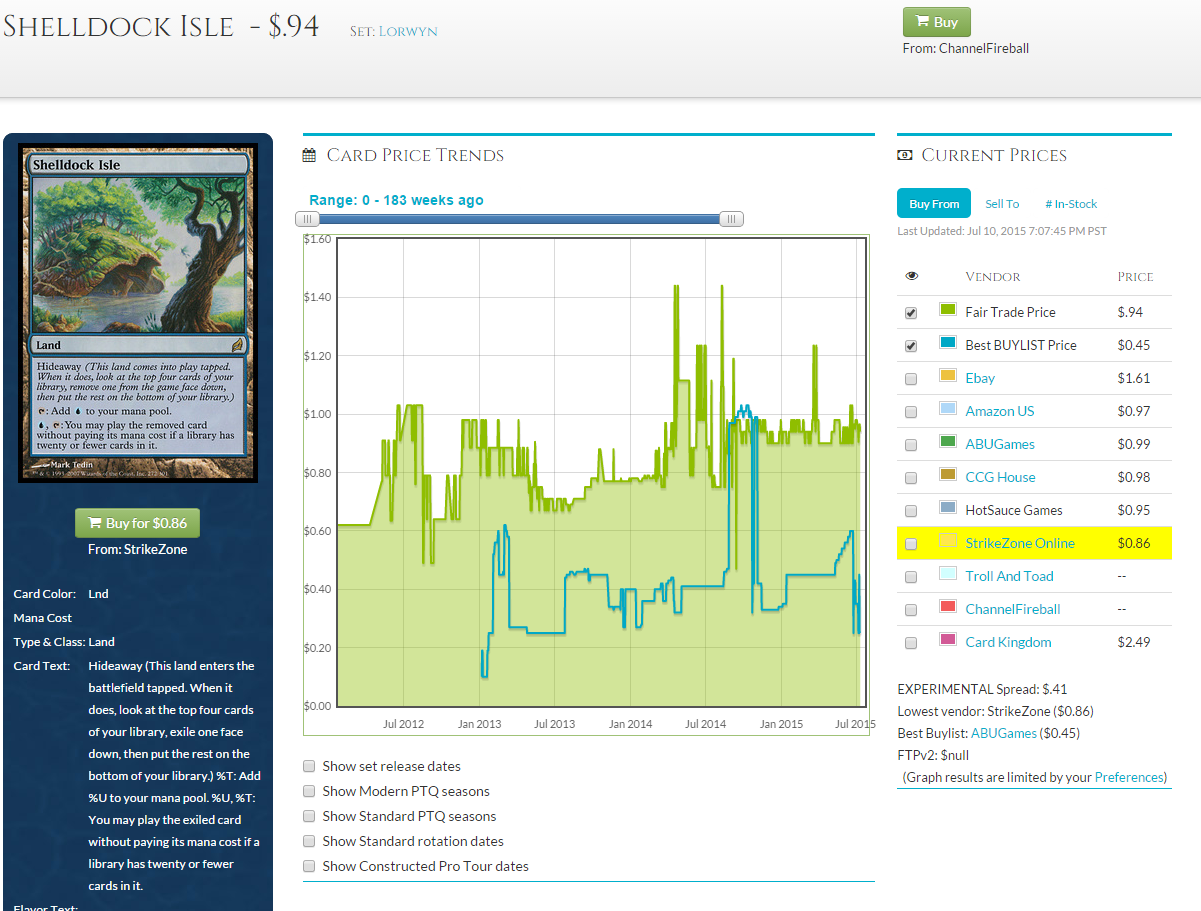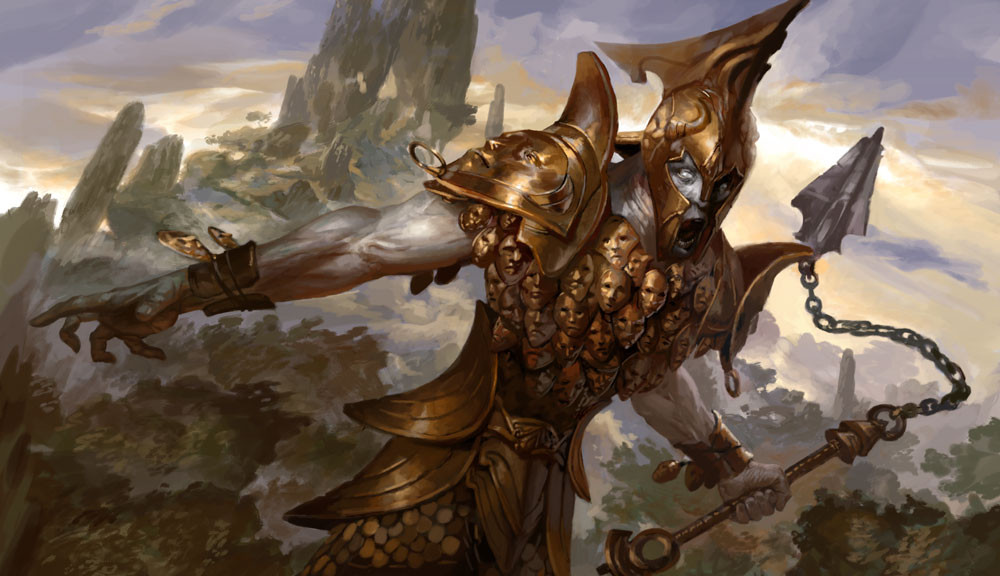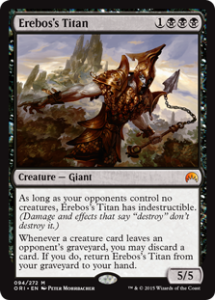Today is going to be a no-nonsense look at what is very potentially the softest sub-market in Magic for the present and immediate future. The cards that we are going to discuss today are not the only ones worth discussing; this is rather a “teach a person how to fish”approach, where you are able to take the parameters (as well as apply your own!) in order to make informed decisions for yourself. There will be a complementary thread in the forums for you to share your own thoughts and targets, so as to be a more long-lasting (and more secure!) discussion than the comment section (which is typically reserved for you people to tell me how great I am).
Tag Archives: Speculation
Conditional Value
“I just want the cheapest copy you have. It’s for personal play, and I’m just trying to build the deck on a budget.”
–Probably one of my local customers
Man, I misuse quotations a lot. You wouldn’t know this if I didn’t tell you, but I didn’t actually document that quote from some local guy I know. I mean, people have said similar stuff to me over the years, but I probably shouldn’t use actual quotation marks for it.
Anyway, what have we got to write about this week? Fetches? Boring. From the Vault: Lack of Linvala? I really don’t care. I’d rather continue on my track as a brilliant comedy writer who basically wrote A Modest Proposal in MTG finance form (it’s right freaking here, for those who haven’t read it). As much as I’d love to continue writing satire and reading the comments, I do kind of get paid to provide useful and actionable financial information about our lovable little economy. I’m hopping back to more of a Finance 101 topic this week, where we’ll go over card conditions and why you shouldn’t write off buying and selling slightly played (SP), moderately played (MP), and heavily played (HP) cards.
Tell Me More
Let’s go back to that opening made-up quote. This more often applies to Legacy, Modern, or EDH than Standard, where the prices on dual lands, fetches, and older staples are symbolic of there not being enough to go around. Not all of the original dual lands have withstood the past twenty years of wear, and the ones that have been used as sandpaper have a price tag to show it. As a result of this, players on a budget who just care about the end result of finishing their decks are more often than not willing to sacrifice card condition to complete that goal.
Take a look at this Tundra, for example: it was one of the first dual lands I ever picked up, and I paid approximately 50 percent of retail for it, because it looks like someone smoked a cigarette directly onto the card for two days straight. (Seriously. The pictures below don’t capture just how yellow the card is.)
“Yes, DJ. Used merchandise sells for cheaper than brand new stuff. That’s obvious. Why are you telling me this?”
Well, Mr. Stereotypical Devil’s Advocate Who So Many MTG Financiers Invoke in Their Articles, I’ll tell you a few things that you can use to take advantage of in the field of less-than-NM cards.
StarCityGames.com gets a lot of flak for having singles that are often priced slightly higher than the rest of the internet, but I’ve never seen a more strict grading system in action when ordering cards from the company. Last year, I ordered 40 copies of Ghave, Guru of Spores from SCG. Ten of those were NM and 30 were SP, and I paid 50 cents less on each of the SP copies. When the cards arrived, I couldn’t even tell that some of them were SP. I ended up grading around half of them as NM, and sold several on TCGplayer and out of my local display case as NM with no complaints.
If you’re ever looking to go deep on a particular spec target, I highly recommend checking out the SP and MP sections of SCG. My local customers will tell you that I’m a tough grader, and even I had trouble finding marks on the cards that would justifiy them being slightly played. Another side benefit of ordering from SCG will be that you’ll be guaranteed to have your order shipped to you, with no concern over cancellation or shipping worries.
On the Other Hand…
Let’s say you have a card that you graded as NM, and you throw it up on TCGplayer. You sell the card, package it up, ship it out, you know the drill. You’re happy to have a sale. However, you get a message about a week later. The buyer is unhappy with the condition of the card because he found a nick or two that he believes knocks it down to SP. Now they want a refund—either a partial return on their purchase for the condition or a full refund with them shipping the card back to you. Sometimes they’re correct, and sometimes they’re just being too critical of a grader. Neither of those choices are very appealing though, and unfortunately, there’s not a whole lot you can do about it.
However, I’ve never had anyone counterclaim my grading of SP or worse cards. The line in the sand between SP and MP can often be blurry, and I’ve definitely listed some cards on TCGplayer as SP that some people might argue as being MP. Even so, buyers have never messaged me about it. They purchased the card expecting some amount of wear, and were satisfied with their purchase costing less than an otherwise minty version would have run them. If you err on the safe side and list it as SP, you’ll remove most picky graders from the equation and not suffer a huge loss in the process. I’m not suggesting to list this thing…
…as “SP” and cross your fingers hoping that you don’t get hate mail, but you can probably get away with posting it as HP instead of just straight up “damaged.”
A Rough Guideline
If you’re new to Magic or to the seller’s side of the game, I recommend checking out TCGplayer’s condition guide for grading. While I think it might be a little bit too strict on the definition of LP or MP, it certainly gets the job done if you’re trying to successfully sell on TCGplayer or eBay.
Only the NM Shall Pass
When trying to sell off SP and worse cards, it’s important to remember that some businesses don’t allow you to trade or sell them. PucaTrade is a website where a lot of heated discussion over condition takes place. Some users don’t take the time to read the requirements of sending a card, and don’t understand that unless notifying their trade partner beforehand, it is not okay to ship out cards that are SP or worse condition while expecting the full point value.
StrikeZoneOnline is a vendor with a buylist that only accepts NM cards, and grades extremely strictly. If you send cards that are even close to questionable on condition, StrikeZone will send you back the cards that they rejected and remove the cost of shipping from your payment amount. If you’re an inexperienced buylister and ship to them expecting to get a simple “condition discount” like CardKingdom offers, then you’ll end up very disappointed. StrikeZone will almost always pay top dollar on foils if you keep your eye out on their graph line on MTGPrice, but you need to be sure that there’s absolutely no clouding, smudging, or edge wear at all before you send the company cards. Interestingly enough, I’ve found StrikeZone’s grading system to be much more lax in person when I sit down to sell to them at Grands Prix. I don’t know if this is because it’s harder to be strict when you have someone sitting across from you to dispute your grading, but I’ve definitely shipped the company SP cards in person and been paid in full.
Everything Comes Back to Cube/Commander
It seems like every time I write an article, there’s at least some mention of Commander or Cube. These two formats allow for some of the most unique personal expression in Magic, and have some of the more interesting house rules or restrictions when building, so it’s no wonder that financiers can end up finding unique ways to cater to these types of players. I once attended an SCG Open and spectated a draft where a player had a cube composed of entirely HP or worse non-foil cards.
He didn’t want to pay the full price to obtain his otherwise expensive cube, so he decided to make a game out of building the cube itself, while at the same time helping the cube be more affordable. The Jace, the Mind Sculptor in that cube looked like it had been used to paint somebody’s driveway, and certain text boxes weren’t even visible anymore. However, he proudly explained that he had only paid $40 to a vendor that was dying to get rid of it, as he ticked up the loyalty on a card who’s initial loyalty placement in the bottom right had been peeled away at some point.
If you’re trying to build a budget cube without dropping the power level to commons and uncommons only, then this might be your way to go. Challenge yourself to only include cards that you find in the parking lot, or something to that effect, and you’ll be done in no time. While I’ve never actually seen someone do the same with a Commander deck, it could certainly be done, and it would be a much cheaper alternative that comes with a story every time you sit down to play it.
End Step (NSFL)
If you’re a fellow Redditor and looking to see some of the most destroyed cards that Magic has to offer, I recommend indulging in MTGgore. While a “flip it or rip it” phase seems to have taken over a little bit, there’s some sort of sick pleasure obtained from looking at picture of a Legacy deck that just went through the wash. It’s like watching a dumpster fire: there’s no value to it, but you just can’t look away.
A Gentle Reminder: Looking Past Origins
It’s not a very well-kept secret that I strongly dislike speculating on anything from a new set. When almost every single card in every new edition is at a high price from hype alone, I’m not a huge fan of trusting competitive players’ instincts about what card will be the next Deathmist Raptor, Boros Reckoner, or Courser of Kruphix. I’ll leave figuring that puzzle out to the people who actually play this game for a living, and try to focus on the most consistent and loss-proof ways to grind value out of the game on my end.
Don’t Call Me a Speculator
As you can tell by a majority of my articles and Twitter activity, my time and cash is usually spent buying collections and singles at buylist prices from people who need or want to liquidate their investments in the game, and then reselling those cards through outs like Facebook, TCGplayer, my display case, and Craigslist. When I do dabble in speculation, I try to minimize my risk as much as possible, even if it means waiting on a long-term investment over a number of years.
That’s why instead of writing a listicle like “Top Five Origins Cards That I Think Are Undervalued!” I’m going to try and remind everyone that you don’t have to be looking for money in Origins just because it’s the hot new thing off the printing presses. Instead of trying to crack the Magic code and find the next Outpost Siege or Mastery of the Unseen, I have my sights set on targets that I think will avoid a reprinting in the long term, hold a strong new price point if and when they do spike, and are relatively cheap and easy to buy into right now without anyone else fighting over them.
That being said, I still very rarely “buy into” cards with cash at full retail anymore, even for speculating purposes. Most of my owned stock of the following list comes from PucaTrade credit that I have stored up, picks from bulk lots that I’ve pulled for essentially free, or singles that I bought at buylist prices but didn’t want to sell at the moment because I felt that the card had a bright enough future. Now that those statements are out of the way, let’s get to the list of cards that I think you should have your eye on instead of Origins, especially if you’re not exactly a Standard player.
Yes, one of them is a common and the other is an uncommon. Glistener Elf also got thrown its own Event Deck printing and FNM promo, so I’m not entirely sure if the ceiling on this is equal to good, old Exarch. However, I pull these constantly from collections, and the buylist outs are only ranging between 20 and 35 cents. That just doesn’t feel right for a four-of staple in a competitive Modern archetype that was from a set like New Phyrexia. Every time I pull these, I simply set them aside, and I’m willing to wait the required months before we start seeing this as a $2 common that the Modern format has come to accept as a normality.
While I don’t think there’s any rush to go buy out the internet before they spike tomorrow (as you can see, I tweeted the above over a month ago and have seen next to zero gains), it’s something that I would get in on sooner rather than later if you plan on playing the deck, and something I would hold back on buylisting for now if you’re comfortable with waiting into the long term for larger rewards.
Apparently my memory wasn’t entirely accurate in the tweet, since Phyrexian Unlife originally jumped to only $3.00 from 30 cents—so only a 1,000-percent increase instead of what I had originally remembered from a year ago.
Something else I remember from a year ago is everyone calling Amulet of Vigor an inconsistent cheese deck that was just a simple flash in the pan. The deck was cheap and easy to build at the time, and Amulet itself had already jumped once. Another New Phyrexia card highlighting the awesome mechanic that is infect, and I can’t see it being printed again until Modern Masters 2017.
Is Ad Nauseam going to take Twin’s place as the throne holder of the most popular combo deck in Modern? No, probably not.
However, Living End didn’t have to put a bunch of copies into the top eight of a Grand Prix to convince the world that it needed to be a $13 in the past couple of weeks. It had a severe case of “being a Modern-legal rare with zero reprints and seeing play in a deck,” which caused it to jump. It’s also the cornerstone of one of the cheapest decks you can build in the format, with the most expensive card being a $15 common that we all know and love (Serum Visions, for those who were scratching their heads). You can purchase the entire deck for less than three copies of Tarmogoyf, and that’s certainly going to be an attractive dealbreaker for new players looking to enter the Modern format on a budget.
While there are still 100 to 200 sellers of each combo piece on TCGplayer, and I don’t expect a buyout within the next few weeks, I don’t think these two cards are safe from jumping up with sudden demand. If the deck starts to see even a glimmer of a consistent competitive showing or a banned list announcement shakes up the format with the coming of Battle for Zendikar, I want to be the one holding these cards months in advance to sell into any future hype.
One of the last cards I want to talk about this week is Shelldock Isle.
You’re probably thinking right now:
But DJ! You just listed three niche Modern cards that have already seen competitive play and haven’t spiked yet. Is there some sort of amazing Shelldock Isle deck that’s going to spike the next Modern Grand Prix? How many hundreds of copies should I buy?
Well, don’t get your hopes up. I don’t exactly know what deck is going to play this. Maybe it spikes eventually due to some crazy Modern deck, and maybe it slowly creeps up over time because casual players are infatuated with the idea of reducing an opponent’s library to zero cards. Either way, we have a utility land with no reprints, a weird mechanic, casual appeal, and theoretical competitive appeal.
If someone told you a year ago that Nourishing Shoal would be a $10 card, you would have called them an idiot. I would have called them something less mean than idiot, but still would’ve given them a stern talking to about their life choices that had led up to that pronouncement. However, Magic: The Gathering players proved us both wrong, came up with a silly combo deck that uses a bulk rare from Kamigawa, and ta-da! $10 card overnight. And Shoal doesn’t even have an ounce of appeal to EDH or casual players, or a weird mechanic that would prevent it from being reprinted in another set in the future.
…
If you’re still tapping your foot and waiting for an example of where I actually made money off of this strategy (I wasn’t one of the people holding onto dozens of Nourishing Shoals when they became relevant), then I ask you to look at another card in the Ad Nauseam deck that recently came to fruition.
Spoils of the Vault was, up until quite recently, a near-bulk rare. Every now and again when I bought collections, I would pull these out of the pile of bulk rares that I picked up at a dime a piece, and throw them into my spec box. “Maybe one day…” I would think longingly. Ad Nauseam didn’t have to win an event for Spoils to give me my spoils, and it certainly won’t have to for either of its other friends in the deck to see a bump. While Spoils was printed approximately sixteen-thousand years before New Phyrexia or Shards of Alara, I still don’t think we’ve seen the last of this deck rearing its’ head in the finance market.
End Step
Maybe you’re a Standard grinder and you found this article completely useless. You bought into Thopter Spy Network and funneled your entire Swiss bank savings into it, and now you feel like an evil genius because you just unloaded your four-hundredth copy for $3 after you bought in at $1. Why jump in on Shelldock Isle, which will take several months (optimistically), if you have a hawkeye for what’s going to be playable in the first few weeks of Standard? Well, I don’t have a counterargument for that.
If you’re good enough at predicting the Standard metagame and you have the ability to move a lot of cards as soon as you get them in, then you have no reason to cross your fingers on the long haul like I’m doing with the above cards. It makes a lot more sense for you to pinpoint the exact card in each new set that everyone else considers to be best for kindling a dumpster fire and haul in your profits on the Tasigur of the new set. If it works for you, there’s no reason to quit now.
Good luck, and I’ll see you next week!
Strength of Languish
Since the exit of Supreme Verdict, players who enjoy resetting the battlefield have struggled to find an ‘always good’ sweeper. Crux of Fate and End Hostilities were too late at five mana, unless you’re the only dragon owner in a control mirror. Drown in Sorrow and Anger of the Gods just never seemed to get everything in games two and three. Now, I feel Languish is filling the void at the CMC we expect from a sweeper. Sure, it’s not the Damnation reprint everyone and their mother speculate during every spoiler season for the past year, but this should be powerful enough to asset in shaping the future metagame.
The list of creatures it kills is long and probably not worth talking about. The list of creatures it can’t kill are far more important. This could give hints on speculation-worthy rares for new Standard.
Languish doesn’t Kill, but rotates: Most Theros gods (if active), Doomwake Giant, Polukranos, World Eater, Reaper of the Wilds, M15 Soul/”Titan” Cycle.
Languish doesn’t kill, and doesn’t rotate: All Dragondlords (except Ojutai), Erebos’s Titan, Gurmag Angler, Siege Rhino, Tasigur, Archangel of Tithes, Sagu Mauler, Sidisi, Undead Vizier, Surrak Dragonclaw, Woodland Bellower, and Ashcloud Phoenix (4/1 mode).
Clearly not a lot of speculation prospects listed above. Some have multiple printings, don’t have enough power for consistent Standard play, or are already expensive.
 Thoughts on a Languish Standard format
Thoughts on a Languish Standard format
- Elves and goblins have a lot of hype but both easily fall to a well-timed Languish.
- Abzan Midrange or Control will improve with the addition of Languish alongside metagame removal.
- Green-based devotion strategies will fall out or favor due to their dependency on early mana dorks.
- White devotion receives Tier 1 potential with Heliod and Archangel of Tithes at the top end of the curve. Brimaz and Wingmate Roc advance the board without over committing. Banishing Light and Chained to the Rocks (if splashing red) remove problems while also increasing devotion.
- Black devotion receives tier 1 potential. I made many of these validations in last weeks article , Financial Five: Magic Origins. Erebos’s Titan along with the other returnable creatures help recover devotion without losing card advantage.
Focus Cards
Abzan Midrange/Control
Elspeth, Suns Champion ($6) – Even though she has two printings and will be rotating in a few months, she’s still a powerhouse. Languish encourages players to play larger creatures. Elspeth wipes out those creatures.
Ajani, Mentor of Heroes ($10) – Potential value without being affected by Languish and also fits in decks that want to play Languish.
Tasigur, the Golden Fang ($8) – You should already be picking up this card anyway. Surviving Languish is just added to the list.
Mono-White Devotion
Soldier of the Pantheon ($0.50) – Potential evasion & Lifegain to avoid force-blocking
Knight of the White Orchid ($3) – Increasing or quickly recovering devotion while continuing to curve out.
Heliod, God of the Sun ($2) – Easier to turn on with Origins printing Knight and Angel.
Anafenza, Kin-Tree Spirit ($2) – Rewarding you for playing creatures and might even pull a few creatures out of Languish range.
Brimaz, King of Oreskos ($10) – One of the best creatures to cast on an empty board. Best post-Languish play.
Wingmate Roc ($2.75) – A powerful top end to take advantage of your Nykthos.
Mono-Black Devotion
Despoiler of Souls ($1) – Recurring devotion plus reasons from last weeks article.
Bloodsoaked Champion ($1.75) – Recovering devotion plus reasons from last weeks article.
Herald of Torment ($0.25) – Bestow allows sweepers insurance, evasion, devotion assistance.
Master of the Feast ($1.25) – Survives Languish, blocks most dragonlords, evasion.
Final Thoughts
 Languish doesn’t guarantee a defined Standard meta, but it does serve as an arrow pointing us in the right direction. From past experience, the influence of removal has on shaping the meta. It hasn’t always guaranteed a profitable spec, but it does happen an above average amount of the time. Clearly, the largest Standard card pool is going to increase my chance of overlooking deck potential, but we can learn a lot from past Standards. Look at the influence of Hero’s Downfall over the past year. Look at Lightning Bolt or Abrupt Decay and their influence on shaping the eternal formats.
Languish doesn’t guarantee a defined Standard meta, but it does serve as an arrow pointing us in the right direction. From past experience, the influence of removal has on shaping the meta. It hasn’t always guaranteed a profitable spec, but it does happen an above average amount of the time. Clearly, the largest Standard card pool is going to increase my chance of overlooking deck potential, but we can learn a lot from past Standards. Look at the influence of Hero’s Downfall over the past year. Look at Lightning Bolt or Abrupt Decay and their influence on shaping the eternal formats.
Also, with the thought of rotation haunting the back of your mind, that doesn’t mean it’s time to dump anything Theros. Understanding the potential movement of Standard can set up optimal opportunities to dump rotating staples at key moments before they actually crash at the Battle of Zendikar release.
As always thanks for reading
